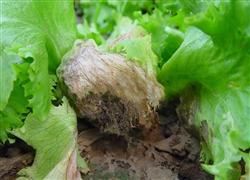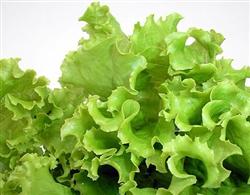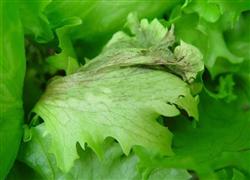What are the common diseases of lettuce?

What are the common diseases of lettuce? Please introduce the production of lettuce in greenhouse in winter, which is prone to a variety of diseases. Several common diseases and control measures of lettuce are summarized as follows: Sclerotinia sclerotiorum mainly harms the base of the stem, the disease is yellow-brown to brown water stains at the initial stage, and then extends to the whole stem, causing the stem to rot or develop upward to cause leaf rot, and finally the plant withered and died. The dense white flocculent mycelium was produced when the humidity was high, and became black mouse fecal sclerotia in the later stage. Prevention and control methods: thoroughly remove the sick and residual fallen leaves after harvest and turn deeply. Reasonable close planting to reduce field humidity. Spray the planting point with 25% triadimefon wettable powder before planting. Chemical control can be used 40% flusilazole EC 3000 times liquid, 50% isocyanate wettable powder 1500 times liquid, 25% imidamide EC 1000 times 1500 times liquid spray, focus on spraying stem base and base leaves, spray once every 7 to 15 days, 2 times for 3 times. Downy mildew mainly harms the leaves, generally the lower leaves get sick first, and gradually spread upward. Light yellow near-round or polygonal disease spots appeared on the leaves at the initial stage. When it is wet, the disease spot on the back of the leaf will grow into a white mildew layer, and in severe cases, the mold layer will spread to the front of the leaf, and in the later stage, the disease spot will become yellowish brown, and the plant will die. Prevention and control methods: thoroughly clean up the fallen leaves after harvest and before planting, reasonably close planting, strictly prohibit flood irrigation, timely drainage after rain, reduce field humidity. The control agent can be sprayed on the back of the leaves with 72.2% aldicarb 600x liquid and 50% dilute morpholine 1500 times liquid, with an interval of 7 days and 2 times continuously. Botrytis cinerea can occur at both seedling stage and adult stage. The disease occurred at the seedling stage, and the damaged stems and leaves rotted in the form of water. The disease occurs in the adult stage, starting from the leaves near the ground, showing a water-immersed irregular disease spot at first, then expanding into brown, and the base is reddish brown. When the disease is serious, it rots upward from the base, and the stems and leaves wither. When the humidity is high, the disease produces a grayish brown or grayish green mildew layer. When the weather is dry, the diseased plants gradually dry up and die, and the mildew layer changes from white to gray to green. Prevention and control methods: the management of adult plants should be strengthened, ventilation should be increased, air humidity should be reduced as much as possible, and once diseased plants are found, they should be removed and destroyed outside the shed. Before planting, the 1000-fold solution of 50% benzothiazide wettable powder was used to spray the soil, walls and film of the greenhouse, and the surface was sterilized. The medicament can be treated with 1000 times solution of Enzema and 500x solution of Shijiale, etc., once every 7 days, and sprayed continuously for 3 times. Leaf scorch disease mainly harms leaves, mostly from the outer leaf or the edge of heart leaf, brown necrotic plaques appear at the initial edge of infected leaves, with the development of the disease, the edge of leaves become scorched, the color of leaves fade, and finally all wilt and die. Prevention and control methods: keep the soil moist and suitable water content, prevent the field temperature from being too high or too low, advocate the use of enzyme bacterial fertilizer, improve soil physical and chemical properties, and avoid excessive watering and fertilization. The medicament can be sprayed with 14% ketamine water 350x liquid, 72% agricultural streptomycin sulfate 2000 times liquid, etc., once every 7 days, and continuously sprayed 2 times for 3 times. Click for more lettuce planting techniques click to get more vegetable planting techniques
- Prev

How to improve the quality of lettuce?
How to improve the quality of lettuce? Please give guidance on lettuce planting. If you want to improve the quality of lettuce, you can refer to the following methods: first, the requirements for the environment: the most suitable temperature for growth is 1622 degrees Celsius during the day and 10 degrees Celsius at night, but it can withstand a high temperature of 30 degrees Celsius and a low temperature of minus 1 degrees Celsius.
- Next

How to prevent and cure lettuce brown spot?
How to prevent and cure lettuce brown spot? Please introduce the control methods of lettuce brown spot mainly harms the leaves, generally through seed disease and wind and rain transmission, spread, infection, poor plant growth or partial application of nitrogen fertilizer will lead to the aggravation of the disease. There are two symptoms of the disease: one is the initial appearance of waterlogging.
Related
- Where is it suitable to grow horseradish in China? it is expected to see the middle altitude horseradish in Alishan.
- How to prevent tomato virus disease reasonably? (Control methods included)
- Many people like to plant towel gourd on the balcony. What are the main points of this method and management?
- What crops can chili peppers be mixed with?
- Fertilization techniques and matters needing attention in Tomato
- What are the grafting techniques for peach seedlings in spring?
- Harm and control methods of root swelling disease of Chinese cabbage
- What are the pests of sweet potatoes? How to prevent and cure it?
- Symptoms, causes and Control methods of navel Rot in Tomato
- The cause of "Cucumber rotten bibcock" in Farmers' planting Cucumber and its Control Plan

